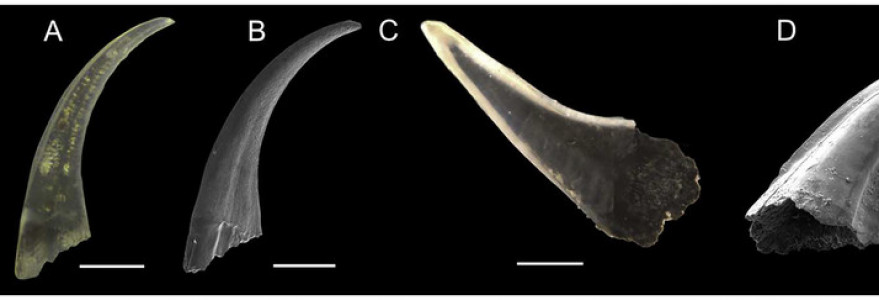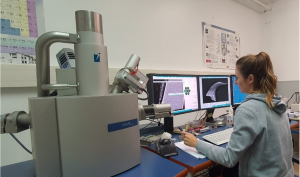Conodonts were the first vertebrates that used to live in oceans nearly 500 milion years ago. Their teeth are the most often studied fossils. The research by UW doctoral candidate helps to reveal the life cycle and position occupied in the earliest foodwebs by these marine animals.
The study was conducted by Isabella Leonhard, at the time a Masters student of Geosciences and Paleobiology at Friedrich-Alexander University in Erlangen, currently a doctoral candidate at the University of Warsaw, in cooperation with researchers from Utrecht University, the Oxford University Museum of National History and the US Geological Survey.
“Conodonts were abundant in the early oceans, but almost all they left behind are microscopic teeth made of material similar to human tooth enamel. Since conodonts’ teeth are highly diverse in shape, from simple cone- to complex platform-like morphologies, which indicate different feeding strategies, we posed a question: did the appearance of hard teeth lead to the rise of predators?”, explained Isabella Leonhard.
Using synchrotron X-ray tomography, high-resolution scanning electron microscopy and chemical analysis, the team focused on the simplest, most primitive forms of conodonts – shaped like simple cones or needles.
A glimpse into the fossil record
“Conodonts are an extinct species. Yet they were the first of all the vertebrates to start producing skeletons – hard organs permeated with minerals. Skeletons such as bones and teeth give scientists a much easier glimpse into the fossil record than soft tissues such as muscles and skin, so the appearance of first skeletons was a major boost to our understanding of where we, the vertebrates, come from”, said Leonhard.
Tooth structure like tree rings
“Slicing these microscopic teeth allows us to get a glimpse into the daily life of organisms which lived nearly 500 million years ago. Conodonts differ from other vertebrate teeth because they kept growing throughout the life of an animal – adding, constantly and periodically, new enamel-like structures upon the youngest surface. This creates a record similar to tree rings, where each episode of the organism’s life is preserved”, as Leonhard described. “Advanced conodonts, which fed as predators, usually have surfaces of wear and damage resulting from gnawing on hard prey, but the most primitive conodonts did not show such traces. Tooth-like structures seemed to had evolved before the onset of actual predatory behaviour. This can be attributed to different environmental circumstances: the earliest conodonts were skulking around in early Palaeozoic oceans in which larger predators were still absent. With the appearance of those, in the course of the Palaeozoic, conodonts may have started to adapt to an ecosystem in which they had to compete against new, larger predators”.
The team revealed that the earliest conodonts developed hard skeletons, but were not predators yet. They differed from advanced forms, which developed sharp shearing organs and fed as predators and/or scavengers. These results show that hard teeth enforced by minerals pre-dated their role in crushing and grinding hard food.
The study is published in this month’s issue of “PeerJ – Life and Environmental Science”: DOI 10.7717/peerj.12505.
2021. Growth and feeding ecology of coniform conodonts. PeerJ 9:e12505 https://doi.org/10.7717/peerj.12505.





